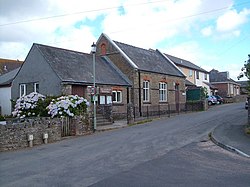East Allington
| East Allington | |
| Devon | |
|---|---|
 East Allington parish hall | |
| Location | |
| Grid reference: | SX769484 |
| Location: | 50°19’24"N, 3°43’47"W |
| Data | |
| Post town: | Totnes |
| Postcode: | TQ9 |
| Local Government | |
| Council: | South Hams |
East Allington is a village in souttherm Devon, three miles south of Halwell and just off the A381 road, about three miles from Kingsbridge and ten miles from Totnes. The coast at Slapton Sands is about five miles to the south-east.
The parish population was counted at 596 in 2001: a small increase from the figure of 396 recorded in 1901.[1] Also in the parish is the hamlet of The Mounts, about a mile away from the village.
East Allington is part of Stanborough Hundred of Devonshire.
Parish church
The church, dedicated to St. Andrew, overlooks the village from a hillside position. The first rector here was presented in 1268, and Bishop John Grandisson dedicated the altar in 1333. The present building, however, dates from the 15th and 16th centuries.[1]
History and modernity
It was in East Allington Church, on 12 November 1943, that the announcement was first made to the people of a large part of the South Devon that they were all to be evacuated from the area by 20 December 1943.[2] Although nobody was told the reason, it was because The War Office had chosen to use Slapton Sands to rehearse the D-Day landings, as the beach at Slapton is very similar to the beach at Normandy which had been chosen for the landings. Ultimately, 749 American soldiers lost their lives at Slapton Sands in April, 1944 in a German attack during the exercises.
Today, East Allington is a thriving village, with some new housing. It has a church, primary school, village hall, public house and recreation ground. Every year the road through the village is closed for the whacky races[3] which involve home-made soap box style go-karts racing downhill against the clock along a course lined with hay bales and crowds of people.
Fallapit
Fallapit was an estate held by a junior branch of the Fortescue family whose progenitor first settled in England in the 12th century in the vicinity of Modbury in South Devon and was granted the estate of Wimpstone near Modbury by King John in 1208.[4] The estate was acquired by Sir Henry Fortescue (fl. 1426), Lord Chief Justice of the Common Pleas in Ireland, by his second marriage to the daughter and heiress of Nicholas de Fallopit.[5]
The house was rebuilt circa 1810-15 in a pseudo-Elizabethan style near the site of the ancient mansion, and was "enlarged and beautified" in 1849.[6] Before 1870 the Fortescues sold the estate to William Cubitt (1834-1891), the sixth son of Thomas Cubitt (1788-1855), co-founder of the famous London building firm.[7] He was a younger brother of George Cubitt, 1st Baron Ashcombe (1828-1917). William was a JP for Devon and a lieutenant in the Coldstream Guards. He kept a pack of foxhounds at Fallapit[8] and in 1875 financed the parish church of St Andrew to the sum of £2,500. An inscribed brass plate in his memory exists in the church.
In 2008 the house was split into 8 apartments and retains only 20 acres of the former large estate.[9]
Outside links
References
- ↑ 1.0 1.1 Harris, Helen (2004). A Handbook of Devon Parishes. Tiverton: Halsgrove. p. 163. ISBN 1-84114-314-6.
- ↑ Putt, Jane. "The Evacuation of the South Hams". BBC. http://www.bbc.co.uk/history/ww2peopleswar/stories/25/a8633225.shtml. Retrieved 5 July 2016.
- ↑ http://www.eastallingtonwhackyraces.co.uk
- ↑ Vivian, Lt.Col. J.L., (Ed.) The Visitations of the County of Devon: Comprising the Heralds' Visitations of 1531, 1564 & 1620, Exeter, 1895, pp.352-3, pedigree of Fortescue
- ↑ Vivian, p.353
- ↑ Hoskins, W.G., A New Survey of England: Devon, London, 1959 (first published 1954), p.318
- ↑ Hero of the Fleet: Two World Wars, One Extraordinary Life - The Memoirs of William Stone
- ↑ Hero of the Fleet: Two World Wars, One Extraordinary Life - The Memoirs of William Stone [1]
- ↑ http://www.rightmove.co.uk/property-for-sale/property-39586840.html